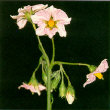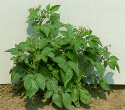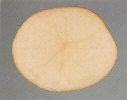Click on Image for Larger View
General
- Origin & Breeding: bred by the USDA from the cross (Katahdin x Chippewa) and selected by Presque Isle Station, Maine, in 1932.
- Year registered in Canada: 1940
- Registration number: 318
- Maturity: late to very late
Botanical Features
- Plants: large, erect to spreading; stems thick, prominently angled; internodes reddish purple; wings prominent.
- Leaves: open, medium long, broad.
Primary leaflets: large, broadly ovate; three pairs.
Secondary leaflets: medium in number.
Tertiary leaflets: few. - Flowers: lilac to reddish purple; green buds; blooms all season until vine desiccation.
- Tubers: elliptical to round-elliptical, medium thick; smooth ivory yellow skin; shallow eyes; white flesh.
- Sprouts: grayish purple.
Agricultural Features
High yielding variety; fair to good storage quality; short dormancy period; sets few tubers if plants closely spaced. Medium specific gravity.
- Utilization: fair to good for boiling, baking, chipping and french frying, depending on maturity.
- Chief Market: fresh market, chipping, mainly for exportation.
Reaction to Diseases
Resistant: wart disease, yellow dwarf.
Highly resistant: PVA.
Moderately resistant: common scab, fusarium dry rot (Fusarium coeruleum), late blight, early blight, tuber net necrosis, verticillium wilt, PVY.
Susceptible: leaf roll, phoma rot, PVX.
Highly susceptible: blackleg, fusarium dry rot (F. sambucinum).
References: 1, 6.
Send your comments to cfia.potatosection-sectiondespommesdeterre.acia@inspection.gc.ca regarding potato variety descriptions.





